Graduate+School+of+Culture+Technology
-
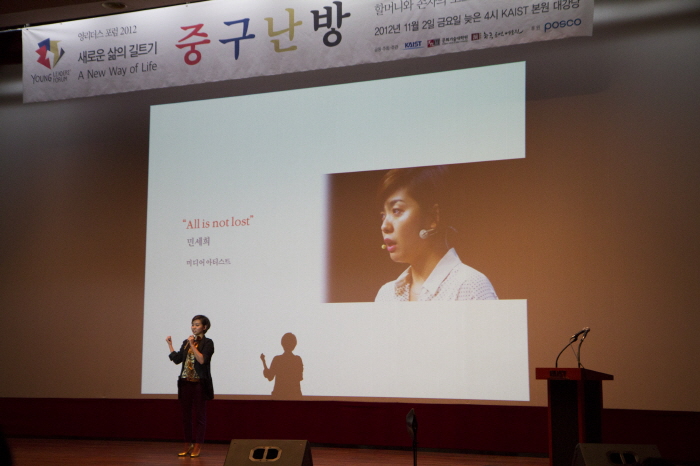 Collaborated Performance and Talk Battle Event Held by Graduate School of Culture Technology, KAIST
A unique event consisting of a new media performance and talk battle was held for middle school, high school, and college students during the winter break.
The Graduate School of Culture Technology at KAIST and the Korea Art Conservatory co-organized the 3rd Young Leaders Forum under the title “Collaboration of the Current and the New Culture” on January 18th at the Seoul Namsan Traditional Theater.
The Young Leaders Forum was founded to share knowledge and wisdom among different fields and generations and to foster creative lifestyles through the collaboration of wisdom.
The collaborated performance, “The Garden of Western Heaven”, was performed using new media technology by students from the Graduate School of Culture Technology and actors from the Korea Art Conservatory.
Three panels participated in the “Talk Battle” and held a discussion on “The New Culture from Performance and Collaboration”.
Woong-Rae Cho, CEO of The Mackiss Company, who sponsored the clay road in Gyejok Mountain and the Concert in the Forest, Professor Sung-Kuk Kim from School of Korean Music at Chung-Ang University, and Je-Ho Oh, a graduate student from the Graduate School of Culture Technology at KAIST participated in the discussion and shared their opinions with the audience.
2014.01.27 View 6590
Collaborated Performance and Talk Battle Event Held by Graduate School of Culture Technology, KAIST
A unique event consisting of a new media performance and talk battle was held for middle school, high school, and college students during the winter break.
The Graduate School of Culture Technology at KAIST and the Korea Art Conservatory co-organized the 3rd Young Leaders Forum under the title “Collaboration of the Current and the New Culture” on January 18th at the Seoul Namsan Traditional Theater.
The Young Leaders Forum was founded to share knowledge and wisdom among different fields and generations and to foster creative lifestyles through the collaboration of wisdom.
The collaborated performance, “The Garden of Western Heaven”, was performed using new media technology by students from the Graduate School of Culture Technology and actors from the Korea Art Conservatory.
Three panels participated in the “Talk Battle” and held a discussion on “The New Culture from Performance and Collaboration”.
Woong-Rae Cho, CEO of The Mackiss Company, who sponsored the clay road in Gyejok Mountain and the Concert in the Forest, Professor Sung-Kuk Kim from School of Korean Music at Chung-Ang University, and Je-Ho Oh, a graduate student from the Graduate School of Culture Technology at KAIST participated in the discussion and shared their opinions with the audience.
2014.01.27 View 6590 -
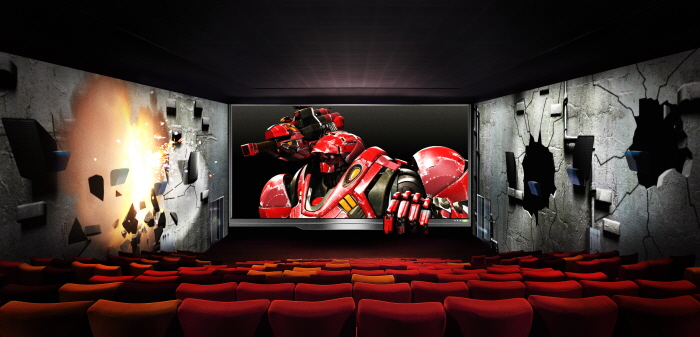 Exhibition of High Technology Held by the Graduate School of Culture Technology at KAIST
Screen X technology, displaying objects simutaneously on three screens
The Graduate School of Culture Technology at KAIST hosted the “2013 Demo Day” on the 1st of November.
The purpose of the Demo Day was to introduce recent research accomplishments on culture technology (CT) to the public and discuss the direction of the future trend of CT.The technologies introduced at the exhibition were: Screen X which simultaneously uses three screens, MagGetz which uses magnets for smart phone applications, Space Touch which connects the virtual reality with the real world, and Avatar that recognizes augmented objects using augmented reality.
Research papers entitled “Digital Art and Entertainment” (Professor Sung-Hee Lee), “Social Network” (Professor Mi-Young Cha), and “Interactive Media and Space” (Professor Ji-Hyun Lee) were presented as well. The Graduate School of Culture Technology was founded in 2005 to combine digital media and culture. Research is conducted largely in the fields of digital art & entertainment, ambient communication, and interactive media & space.
2013.11.20 View 6677
Exhibition of High Technology Held by the Graduate School of Culture Technology at KAIST
Screen X technology, displaying objects simutaneously on three screens
The Graduate School of Culture Technology at KAIST hosted the “2013 Demo Day” on the 1st of November.
The purpose of the Demo Day was to introduce recent research accomplishments on culture technology (CT) to the public and discuss the direction of the future trend of CT.The technologies introduced at the exhibition were: Screen X which simultaneously uses three screens, MagGetz which uses magnets for smart phone applications, Space Touch which connects the virtual reality with the real world, and Avatar that recognizes augmented objects using augmented reality.
Research papers entitled “Digital Art and Entertainment” (Professor Sung-Hee Lee), “Social Network” (Professor Mi-Young Cha), and “Interactive Media and Space” (Professor Ji-Hyun Lee) were presented as well. The Graduate School of Culture Technology was founded in 2005 to combine digital media and culture. Research is conducted largely in the fields of digital art & entertainment, ambient communication, and interactive media & space.
2013.11.20 View 6677 -
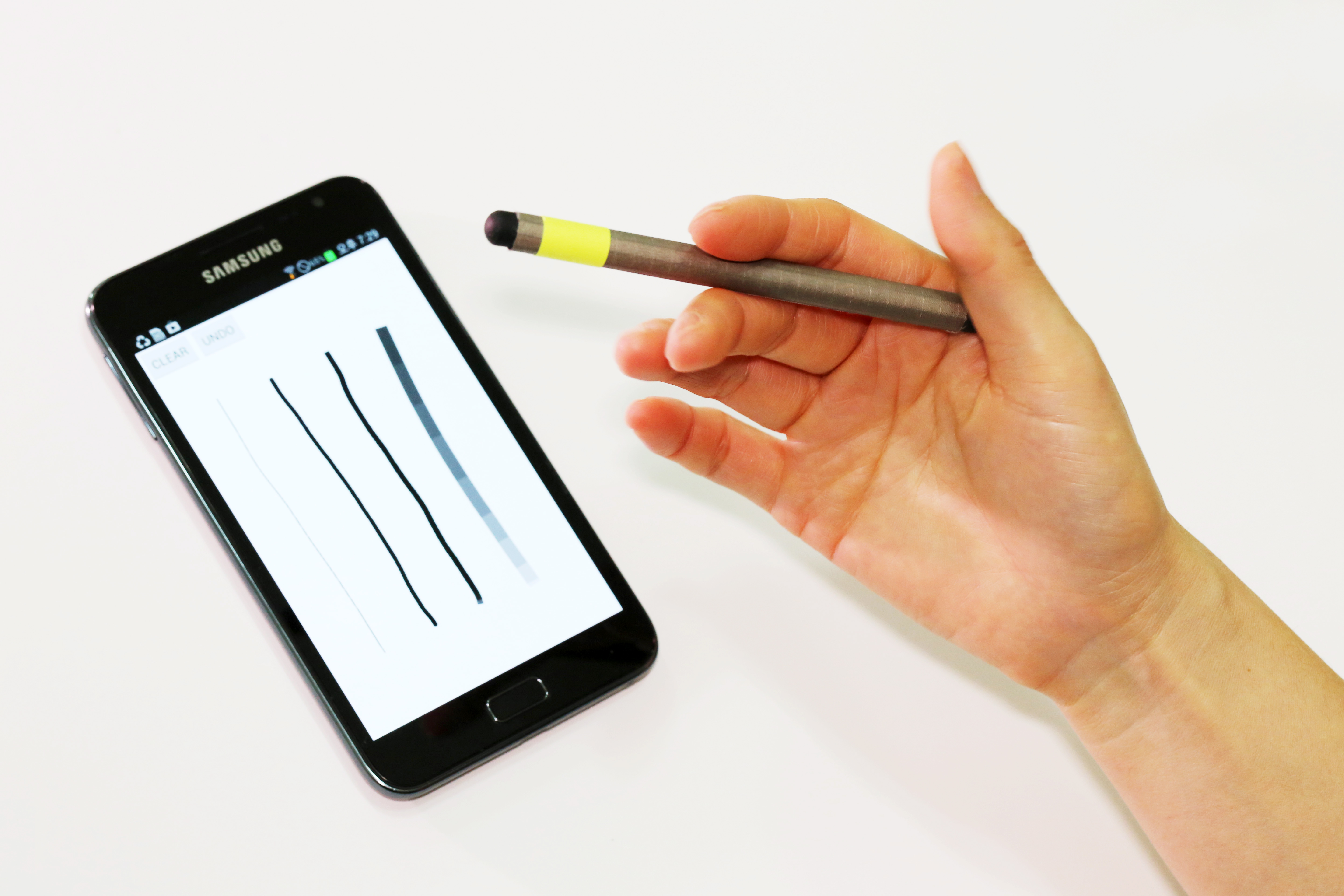 A magnetic pen for smartphones adds another level of conveniences
Utilizing existing features on smartphones, the MagPen provides users with a compatible and simple input tool regardless of the type of phones they are using.
A doctoral candidate at the Korea Advanced Institute of Science and Technology (KAIST) developed a magnetically driven pen interface that works both on and around mobile devices. This interface, called the MagPen, can be used for any type of smartphones and tablet computers so long as they have magnetometers embedded in.
Advised by Professor Kwang-yun Wohn of the Graduate School of Culture Technology (GSCT) at KAIST, Sungjae Hwang, a Ph.D. student, created the MagPen in collaboration with Myung-Wook Ahn, a master"s student at the GSCT of KAIST, and Andrea Bianchi, a professor at Sungkyunkwan University.
Almost all mobile devices today provide location-based services, and magnetometers are incorporated in the integrated circuits of smartphones or tablet PCs, functioning as compasses. Taking advantage of built-in magnetometers, Hwang"s team came up with a technology that enabled an input tool for mobile devices such as a capacitive stylus pen to interact more sensitively and effectively with the devices" touch screen. Text and command entered by a stylus pen are expressed better on the screen of mobile devices than those done by human fingers.
The MagPen utilizes magnetometers equipped with smartphones, thus there is no need to build an additional sensing panel for a touchscreen as well as circuits, communication modules, or batteries for the pen. With an application installed on smartphones, it senses and analyzes the magnetic field produced by a permanent magnet embedded in a standard capacitive stylus pen.
Sungjae Hwang said, "Our technology is eco-friendly and very affordable because we are able to improve the expressiveness of the stylus pen without requiring additional hardware beyond those already installed on the current mobile devices. The technology allows smartphone users to enjoy added convenience while no wastes generated."
The MagPen detects the direction at which a stylus pen is pointing; selects colors by dragging the pen across smartphone bezel; identifies pens with different magnetic properties; recognizes pen-spinning gestures; and estimates the finger pressure applied to the pen.
Notably, with its spinning motion, the MagPen expands the scope of input gestures recognized by a stylus pen beyond its existing vocabularies of gestures and techniques such as titling, hovering, and varying pressures. The tip of the pen switches from a pointer to an eraser and vice versa when spinning. Or, it can choose the thickness of the lines drawn on a screen by spinning.
"It"s quite remarkable to see that the MagPen can understand spinning motion. It"s like the pen changes its living environment from two dimensions to three dimensions. This is the most creative characteristic of our technology," added Sungjae Hwang.
Hwang"s initial research result was first presented at the International Conference on Intelligent User Interfaces organized by the Association for Computing Machinery and held on March 19-22 in Santa Monica, the US.
In the next month of August, the research team will present a paper on the MagPen technology, entitled "MagPen: Magnetically Driven Pen Interaction On and Around Conventional Smartphones" and receive an Honorable Mention Award at the 15th International Conference on Human-Computer Interaction with Mobile Devices and Services (MobileHCI 2013) to be held in Germany.
In addition to the MagPen, Hwang and his team are conducting other projects to develop different types of magnetic gadgets (collectively called "MagGetz") that include the Magnetic Marionette, a magnetic cover for a smartphone, which offers augmented interactions with the phone, as well as magnetic widgets such as buttons and toggle interface.
Hwang has filed ten patents for the MagGetz technology.
Youtube Links: http://www.youtube.com/watch?v=NkPo2las7wc, http://www.youtube.com/watch?v=J9GtgyzoZmM
2013.07.25 View 11687
A magnetic pen for smartphones adds another level of conveniences
Utilizing existing features on smartphones, the MagPen provides users with a compatible and simple input tool regardless of the type of phones they are using.
A doctoral candidate at the Korea Advanced Institute of Science and Technology (KAIST) developed a magnetically driven pen interface that works both on and around mobile devices. This interface, called the MagPen, can be used for any type of smartphones and tablet computers so long as they have magnetometers embedded in.
Advised by Professor Kwang-yun Wohn of the Graduate School of Culture Technology (GSCT) at KAIST, Sungjae Hwang, a Ph.D. student, created the MagPen in collaboration with Myung-Wook Ahn, a master"s student at the GSCT of KAIST, and Andrea Bianchi, a professor at Sungkyunkwan University.
Almost all mobile devices today provide location-based services, and magnetometers are incorporated in the integrated circuits of smartphones or tablet PCs, functioning as compasses. Taking advantage of built-in magnetometers, Hwang"s team came up with a technology that enabled an input tool for mobile devices such as a capacitive stylus pen to interact more sensitively and effectively with the devices" touch screen. Text and command entered by a stylus pen are expressed better on the screen of mobile devices than those done by human fingers.
The MagPen utilizes magnetometers equipped with smartphones, thus there is no need to build an additional sensing panel for a touchscreen as well as circuits, communication modules, or batteries for the pen. With an application installed on smartphones, it senses and analyzes the magnetic field produced by a permanent magnet embedded in a standard capacitive stylus pen.
Sungjae Hwang said, "Our technology is eco-friendly and very affordable because we are able to improve the expressiveness of the stylus pen without requiring additional hardware beyond those already installed on the current mobile devices. The technology allows smartphone users to enjoy added convenience while no wastes generated."
The MagPen detects the direction at which a stylus pen is pointing; selects colors by dragging the pen across smartphone bezel; identifies pens with different magnetic properties; recognizes pen-spinning gestures; and estimates the finger pressure applied to the pen.
Notably, with its spinning motion, the MagPen expands the scope of input gestures recognized by a stylus pen beyond its existing vocabularies of gestures and techniques such as titling, hovering, and varying pressures. The tip of the pen switches from a pointer to an eraser and vice versa when spinning. Or, it can choose the thickness of the lines drawn on a screen by spinning.
"It"s quite remarkable to see that the MagPen can understand spinning motion. It"s like the pen changes its living environment from two dimensions to three dimensions. This is the most creative characteristic of our technology," added Sungjae Hwang.
Hwang"s initial research result was first presented at the International Conference on Intelligent User Interfaces organized by the Association for Computing Machinery and held on March 19-22 in Santa Monica, the US.
In the next month of August, the research team will present a paper on the MagPen technology, entitled "MagPen: Magnetically Driven Pen Interaction On and Around Conventional Smartphones" and receive an Honorable Mention Award at the 15th International Conference on Human-Computer Interaction with Mobile Devices and Services (MobileHCI 2013) to be held in Germany.
In addition to the MagPen, Hwang and his team are conducting other projects to develop different types of magnetic gadgets (collectively called "MagGetz") that include the Magnetic Marionette, a magnetic cover for a smartphone, which offers augmented interactions with the phone, as well as magnetic widgets such as buttons and toggle interface.
Hwang has filed ten patents for the MagGetz technology.
Youtube Links: http://www.youtube.com/watch?v=NkPo2las7wc, http://www.youtube.com/watch?v=J9GtgyzoZmM
2013.07.25 View 11687 -
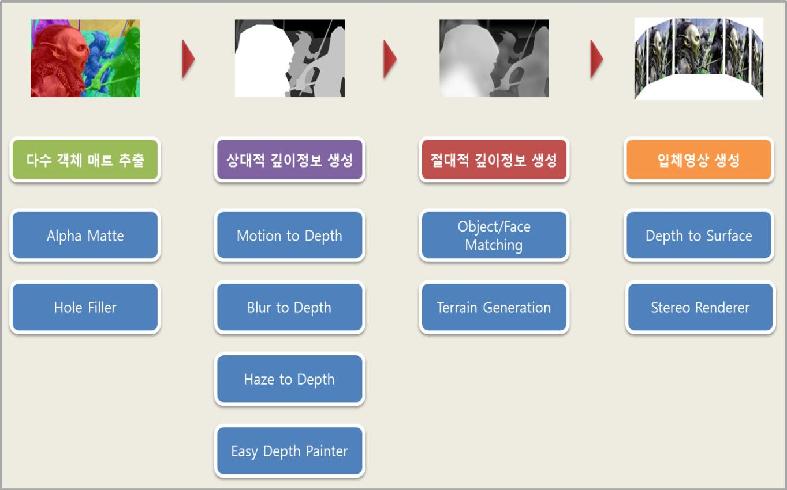 3D contents using our technology
Professor Noh Jun Yong’s research team from KAIST Graduate School of Culture Technology has successfully developed a software program that improves the semiautomatic conversation rate efficiency of 3D stereoscopic images by 3 times.
This software, named ‘NAKiD’, was first presented at the renowned Computer Graphics conference/exhibition ‘Siggraph 2012’ in August and received intense interest from the participants.
The ‘NAKiD’ technology is forecasted to replace the expensive imported equipment and technology used in 3D filming.
For multi-viewpoint no-glasses 3D stereopsis, two cameras are needed to film the image. However, ‘NAKiD’ can easily convert images from a single camera into a 3D image, greatly decreasing the problems in the film production process as well as its cost.
There are 2 methods commonly used in the production of 3D stereoscopic images; filming using two cameras and the 3D conversion using computer software.
The use of two cameras requires expensive equipment and the filmed images need further processing after production. On the other hand, 3D conversion technology does not require extra devices in the production process and can also convert the existing 2D contents into 3D, a main reason why many countries are focusing on the development of stereoscopic technology.
Stereoscopic conversion is largely divided in to 3 steps; object separation, formation of depth information and stereo rendering. Professor Noh’s teams focused on the optimization of each step to increase the efficiency of the conversion system.
Professor Noh’s research team first increased the separation accuracy to the degree of a single hair and created an algorithm that automatically fills in the background originally covered by the separated object.
The team succeeded in the automatic formation of depth information using the geographic or architectural characteristic and vanishing points. For the stereo rendering process, the team decreased the rendering time by reusing the rendered information of one side, rather than the traditional method of rendering the left and right images separately.
Professor Noh said that ‘although 3D TVs are becoming more and more commercialized, there are not enough programs that can be watched in 3D’ and that ‘stereoscopic conversion technology is receiving high praise in the field of graphics because it allows the easy production of 3D contents with small cost’.
2012.10.20 View 10443
3D contents using our technology
Professor Noh Jun Yong’s research team from KAIST Graduate School of Culture Technology has successfully developed a software program that improves the semiautomatic conversation rate efficiency of 3D stereoscopic images by 3 times.
This software, named ‘NAKiD’, was first presented at the renowned Computer Graphics conference/exhibition ‘Siggraph 2012’ in August and received intense interest from the participants.
The ‘NAKiD’ technology is forecasted to replace the expensive imported equipment and technology used in 3D filming.
For multi-viewpoint no-glasses 3D stereopsis, two cameras are needed to film the image. However, ‘NAKiD’ can easily convert images from a single camera into a 3D image, greatly decreasing the problems in the film production process as well as its cost.
There are 2 methods commonly used in the production of 3D stereoscopic images; filming using two cameras and the 3D conversion using computer software.
The use of two cameras requires expensive equipment and the filmed images need further processing after production. On the other hand, 3D conversion technology does not require extra devices in the production process and can also convert the existing 2D contents into 3D, a main reason why many countries are focusing on the development of stereoscopic technology.
Stereoscopic conversion is largely divided in to 3 steps; object separation, formation of depth information and stereo rendering. Professor Noh’s teams focused on the optimization of each step to increase the efficiency of the conversion system.
Professor Noh’s research team first increased the separation accuracy to the degree of a single hair and created an algorithm that automatically fills in the background originally covered by the separated object.
The team succeeded in the automatic formation of depth information using the geographic or architectural characteristic and vanishing points. For the stereo rendering process, the team decreased the rendering time by reusing the rendered information of one side, rather than the traditional method of rendering the left and right images separately.
Professor Noh said that ‘although 3D TVs are becoming more and more commercialized, there are not enough programs that can be watched in 3D’ and that ‘stereoscopic conversion technology is receiving high praise in the field of graphics because it allows the easy production of 3D contents with small cost’.
2012.10.20 View 10443 -
 Graduate School of Culture and Technology Begins Mobile Science Classroom
KAIST Graduate School of Culture and Technology plans visits to elementary schools without the facilities to facilitate hands on science education.
The Graduate School of Culture and Technology planned the ‘STEAM Creative Camp’ involving three elementary schools during the summer holidays.
The ‘STEAM Creative Camp’ involves increasing interest and artistic sensitivity through experience based science education.
The program is composed of two separate programs in consideration to the level of participating students.
The beginner level program includes: code making, writing secret letters, sticker decorating program and the moderate level program includes: making wipers using complex pulley system, catapult design using elasticity, and puppet show using joints to animate.
The programs will be taught by masters and doctorate program candidates from the KAIST Youth Culture and Technology Experience Center.
*STEAM: And integrated education system including Science, Technology, Engineering, Arts, and Mathematics.
2012.07.26 View 9358
Graduate School of Culture and Technology Begins Mobile Science Classroom
KAIST Graduate School of Culture and Technology plans visits to elementary schools without the facilities to facilitate hands on science education.
The Graduate School of Culture and Technology planned the ‘STEAM Creative Camp’ involving three elementary schools during the summer holidays.
The ‘STEAM Creative Camp’ involves increasing interest and artistic sensitivity through experience based science education.
The program is composed of two separate programs in consideration to the level of participating students.
The beginner level program includes: code making, writing secret letters, sticker decorating program and the moderate level program includes: making wipers using complex pulley system, catapult design using elasticity, and puppet show using joints to animate.
The programs will be taught by masters and doctorate program candidates from the KAIST Youth Culture and Technology Experience Center.
*STEAM: And integrated education system including Science, Technology, Engineering, Arts, and Mathematics.
2012.07.26 View 9358 -
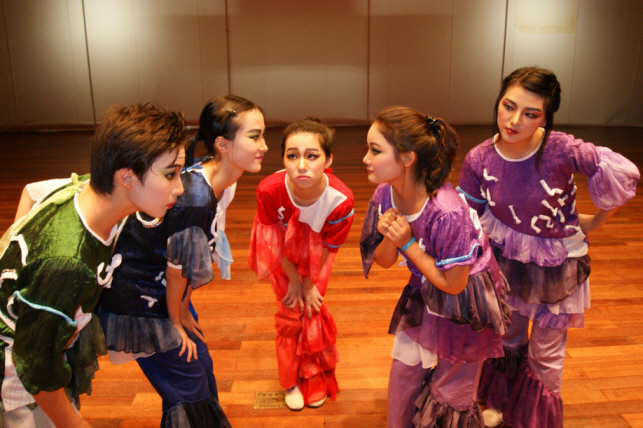 Fusion performing arts, called space musical, 'NARO' performed at KAIST
In commemoration of the 6th anniversary of the establishment of the Graduate School of Cultural Technology, KAIST organized an English musical show on space at the Auditorium on the 29th and 30th of September. The name of the musical was NARO.
The musical was funded by the ‘NaDa Center’ operated by KAIST’s Graduate School of Cultural Technology. The musical was created with participation from adolescents, which told a tale about a genius boy Naro’s journey in space.
The musical was composed of two parts, and the basic storyline was about Naro who conducts research based on space, and his friends went on a time travel to the constellation Scorpios; more specifically, it was a Korean traditional children’s story about a brother and sister who became the sun and the moon. Naro and his friends prevent the plot of Tyran, a villan, who plans on destroying the space and Earth by inducing a red giant star, Antares.
In preparation for the musical, NaDa Center selected 14 students ranging from elementary to high school students during March of 2011. The selected students met every Saturday and Sunday from March to September for practice; a gargantuan commitment.
The theme of the musical is space, the future, and hope, and it does not utilize any stage settings. Instead, it attempts the incorporation of high technology into the stage by using interactive video, laser art, and specially built props. In addition, the entire process from script to performance and advertisement was utilized as an education model to suggest a good fusion between science and technology and cultural arts.
The musical ‘NARO’ is a collective effort. Professor Won Kwan Yeon who pioneered the field of Cultural Technology directed the musical, Professor Koo Bon Chul was in charge of the script and music composition, acting was charged to Lee Min Ho, choreography was charged to Han Eun Kyung, astrological reference was charged to Park Seok Jae among other students in the Graduate School of Cultural Technology. Members of the KAIST Acting Club ‘Lee Bak Teo’, Jeong Soo Han, Son Sharon and graduate of Chung Nam National University with vocal music major Yang Su Ji also made appearances. The Space Musical ‘NARO’ was funded by the Korea Astronomy and Space Science Institute, Korea Aerospace Research Institute, and LG School of Multi Culture.
2011.10.10 View 11246
Fusion performing arts, called space musical, 'NARO' performed at KAIST
In commemoration of the 6th anniversary of the establishment of the Graduate School of Cultural Technology, KAIST organized an English musical show on space at the Auditorium on the 29th and 30th of September. The name of the musical was NARO.
The musical was funded by the ‘NaDa Center’ operated by KAIST’s Graduate School of Cultural Technology. The musical was created with participation from adolescents, which told a tale about a genius boy Naro’s journey in space.
The musical was composed of two parts, and the basic storyline was about Naro who conducts research based on space, and his friends went on a time travel to the constellation Scorpios; more specifically, it was a Korean traditional children’s story about a brother and sister who became the sun and the moon. Naro and his friends prevent the plot of Tyran, a villan, who plans on destroying the space and Earth by inducing a red giant star, Antares.
In preparation for the musical, NaDa Center selected 14 students ranging from elementary to high school students during March of 2011. The selected students met every Saturday and Sunday from March to September for practice; a gargantuan commitment.
The theme of the musical is space, the future, and hope, and it does not utilize any stage settings. Instead, it attempts the incorporation of high technology into the stage by using interactive video, laser art, and specially built props. In addition, the entire process from script to performance and advertisement was utilized as an education model to suggest a good fusion between science and technology and cultural arts.
The musical ‘NARO’ is a collective effort. Professor Won Kwan Yeon who pioneered the field of Cultural Technology directed the musical, Professor Koo Bon Chul was in charge of the script and music composition, acting was charged to Lee Min Ho, choreography was charged to Han Eun Kyung, astrological reference was charged to Park Seok Jae among other students in the Graduate School of Cultural Technology. Members of the KAIST Acting Club ‘Lee Bak Teo’, Jeong Soo Han, Son Sharon and graduate of Chung Nam National University with vocal music major Yang Su Ji also made appearances. The Space Musical ‘NARO’ was funded by the Korea Astronomy and Space Science Institute, Korea Aerospace Research Institute, and LG School of Multi Culture.
2011.10.10 View 11246